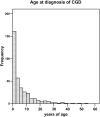Chronic granulomatous disease: the European experience
- PMID: 19381301
- PMCID: PMC2668749
- DOI: 10.1371/journal.pone.0005234
Chronic granulomatous disease: the European experience
Abstract
CGD is an immunodeficiency caused by deletions or mutations in genes that encode subunits of the leukocyte NADPH oxidase complex. Normally, assembly of the NADPH oxidase complex in phagosomes of certain phagocytic cells leads to a "respiratory burst", essential for the clearance of phagocytosed micro-organisms. CGD patients lack this mechanism, which leads to life-threatening infections and granuloma formation. However, a clear picture of the clinical course of CGD is hampered by its low prevalence (approximately 1:250,000). Therefore, extensive clinical data from 429 European patients were collected and analyzed. Of these patients 351 were males and 78 were females. X-linked (XL) CGD (gp91(phox) deficient) accounted for 67% of the cases, autosomal recessive (AR) inheritance for 33%. AR-CGD was diagnosed later in life, and the mean survival time was significantly better in AR patients (49.6 years) than in XL CGD (37.8 years), suggesting a milder disease course in AR patients. The disease manifested itself most frequently in the lungs (66% of patients), skin (53%), lymph nodes (50%), gastrointestinal tract (48%) and liver (32%). The most frequently cultured micro-organisms per episode were Staphylococcus aureus (30%), Aspergillus spp. (26%), and Salmonella spp. (16%). Surprisingly, Pseudomonas spp. (2%) and Burkholderia cepacia (<1%) were found only sporadically. Lesions induced by inoculation with BCG occurred in 8% of the patients. Only 71% of the patients received antibiotic maintenance therapy, and 53% antifungal prophylaxis. 33% were treated with gamma-interferon. 24 patients (6%) had received a stem cell transplantation. The most prominent reason of death was pneumonia and pulmonary abscess (18/84 cases), septicemia (16/84) and brain abscess (4/84). These data provide further insight in the clinical course of CGD in Europe and hopefully can help to increase awareness and optimize the treatment of these patients.
Conflict of interest statement
Figures



References
-
- Winkelstein JA, Marino MC, Johnston RB, Jr, Boyle J, Curnutte J, et al. Chronic granulomatous disease. Report on a national registry of 368 patients. Medicine (Baltimore) 2000;79:155–169. - PubMed
-
- Martire B, Rondelli R, Soresina A, Pignata C, Broccoletti T, et al. Clinical features, long-term follow-up and outcome of a large cohort of patients with Chronic Granulomatous Disease: an Italian multicenter study. Clin Immunol. 2008;126:155–164. - PubMed
-
- Segal BH, Leto TL, Gallin JI, Malech HL, Holland SM. Genetic, biochemical, and clinical features of chronic granulomatous disease. Medicine (Baltimore) 2000;79:170–200. - PubMed
-
- Romani L, Fallarino F, De Luca A, Montagnoli C, D'Angelo C, et al. Defective tryptophan catabolism underlies inflammation in mouse chronic granulomatous disease. Nature. 2008;451:211–215. - PubMed
Publication types
MeSH terms
LinkOut - more resources
Full Text Sources
Other Literature Sources
Medical
Research Materials
Miscellaneous

